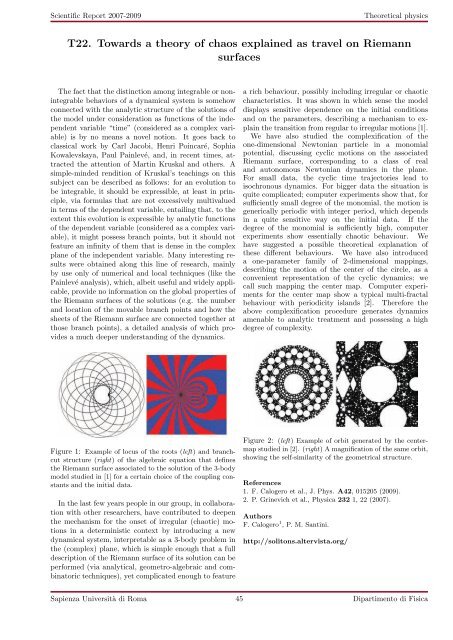download report - Sapienza
download report - Sapienza
download report - Sapienza
You also want an ePaper? Increase the reach of your titles
YUMPU automatically turns print PDFs into web optimized ePapers that Google loves.
Scientific Report 2007-2009<br />
Theoretical physics<br />
T22. Towards a theory of chaos explained as travel on Riemann<br />
surfaces<br />
The fact that the distinction among integrable or nonintegrable<br />
behaviors of a dynamical system is somehow<br />
connected with the analytic structure of the solutions of<br />
the model under consideration as functions of the independent<br />
variable “time” (considered as a complex variable)<br />
is by no means a novel notion. It goes back to<br />
classical work by Carl Jacobi, Henri Poincaré, Sophia<br />
Kowalevskaya, Paul Painlevé, and, in recent times, attracted<br />
the attention of Martin Kruskal and others. A<br />
simple-minded rendition of Kruskal’s teachings on this<br />
subject can be described as follows: for an evolution to<br />
be integrable, it should be expressible, at least in principle,<br />
via formulas that are not excessively multivalued<br />
in terms of the dependent variable, entailing that, to the<br />
extent this evolution is expressible by analytic functions<br />
of the dependent variable (considered as a complex variable),<br />
it might possess branch points, but it should not<br />
feature an infinity of them that is dense in the complex<br />
plane of the independent variable. Many interesting results<br />
were obtained along this line of research, mainly<br />
by use only of numerical and local techniques (like the<br />
Painlevé analysis), which, albeit useful and widely applicable,<br />
provide no information on the global properties of<br />
the Riemann surfaces of the solutions (e.g. the number<br />
and location of the movable branch points and how the<br />
sheets of the Riemann surface are connected together at<br />
those branch points), a detailed analysis of which provides<br />
a much deeper understanding of the dynamics.<br />
a rich behaviour, possibly including irregular or chaotic<br />
characteristics. It was shown in which sense the model<br />
displays sensitive dependence on the initial conditions<br />
and on the parameters, describing a mechanism to explain<br />
the transition from regular to irregular motions [1].<br />
We have also studied the complexification of the<br />
one-dimensional Newtonian particle in a monomial<br />
potential, discussing cyclic motions on the associated<br />
Riemann surface, corresponding to a class of real<br />
and autonomous Newtonian dynamics in the plane.<br />
For small data, the cyclic time trajectories lead to<br />
isochronous dynamics. For bigger data the situation is<br />
quite complicated; computer experiments show that, for<br />
sufficiently small degree of the monomial, the motion is<br />
generically periodic with integer period, which depends<br />
in a quite sensitive way on the initial data. If the<br />
degree of the monomial is sufficiently high, computer<br />
experiments show essentially chaotic behaviour. We<br />
have suggested a possible theoretical explanation of<br />
these different behaviours. We have also introduced<br />
a one-parameter family of 2-dimensional mappings,<br />
describing the motion of the center of the circle, as a<br />
convenient representation of the cyclic dynamics; we<br />
call such mapping the center map. Computer experiments<br />
for the center map show a typical multi-fractal<br />
behaviour with periodicity islands [2]. Therefore the<br />
above complexification procedure generates dynamics<br />
amenable to analytic treatment and possessing a high<br />
degree of complexity.<br />
Figure 1: Example of locus of the roots (left) and branchcut<br />
structure (right) of the algebraic equation that defines<br />
the Riemann surface associated to the solution of the 3-body<br />
model studied in [1] for a certain choice of the coupling constants<br />
and the initial data.<br />
In the last few years people in our group, in collaboration<br />
with other researchers, have contributed to deepen<br />
the mechanism for the onset of irregular (chaotic) motions<br />
in a deterministic context by introducing a new<br />
dynamical system, interpretable as a 3-body problem in<br />
the (complex) plane, which is simple enough that a full<br />
description of the Riemann surface of its solution can be<br />
performed (via analytical, geometro-algebraic and combinatoric<br />
techniques), yet complicated enough to feature<br />
Figure 2: (left) Example of orbit generated by the centermap<br />
studied in [2]. (right) A magnification of the same orbit,<br />
showing the self-similarity of the geometrical structure.<br />
References<br />
1. F. Calogero et al., J. Phys. A42, 015205 (2009).<br />
2. P. Grinevich et al., Physica 232 1, 22 (2007).<br />
Authors<br />
F. Calogero 1 , P. M. Santini.<br />
http://solitons.altervista.org/<br />
<strong>Sapienza</strong> Università di Roma 45 Dipartimento di Fisica

















